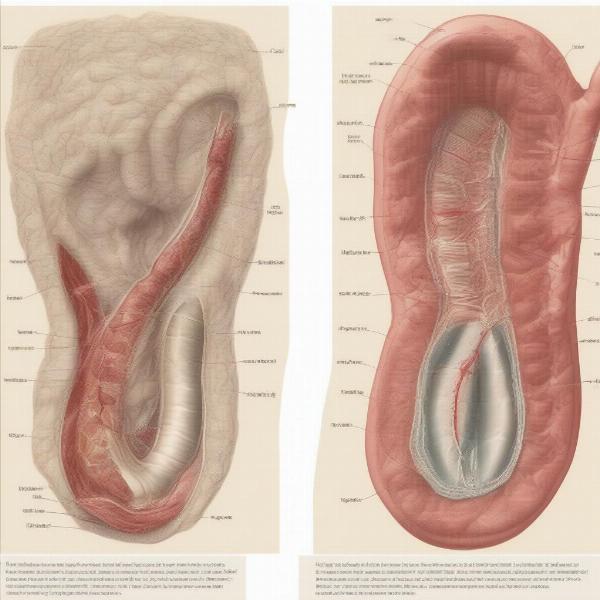Colonic torsion, also known as GDV (Gastric Dilatation-Volvulus) of the colon, is a serious and life-threatening condition that affects dogs. It occurs when the colon twists on itself, cutting off blood supply and leading to rapid deterioration. This guide will provide you with a comprehensive understanding of colonic torsion in dogs, including its causes, symptoms, diagnosis, treatment, and prevention.
Colonic torsion is a less common form of GDV, with gastric dilatation-volvulus (twisting of the stomach) being more frequently seen. However, both conditions are extremely dangerous and require immediate veterinary attention. Understanding the risk factors, signs, and necessary actions can be the difference between life and death for your canine companion. Early diagnosis and aggressive treatment are crucial for a positive outcome. Let’s delve deeper into this critical topic.
Understanding Colonic Torsion
Colonic torsion occurs when the colon rotates around its long axis. This twisting action constricts blood flow to the colon, causing tissue damage and potential rupture. The buildup of gas and fluid within the twisted colon further exacerbates the problem, leading to increased pressure and pain.
What makes a dog more susceptible to this condition? Larger, deep-chested breeds appear to be more prone, though any dog can suffer from colonic torsion. Other risk factors can include excessive gas, a history of gastrointestinal issues, and strenuous exercise after eating.
 Diagram of Colonic Torsion in a Dog
Diagram of Colonic Torsion in a Dog
Recognizing the Symptoms
Recognizing the signs of colonic torsion is paramount. Symptoms can manifest suddenly and worsen rapidly. Common signs include:
- Abdominal pain and distension: The abdomen may appear bloated and hard to the touch.
- Restlessness and pacing: Dogs may exhibit signs of discomfort and inability to settle.
- Non-productive retching or vomiting: Despite attempts to vomit, little to nothing may be produced.
- Weakness and lethargy: Rapid deterioration can lead to collapse.
- Pale gums and rapid breathing: These indicate shock and decreased oxygen supply.
If you notice any of these symptoms, immediately seek veterinary care. Time is of the essence in these situations.
Diagnosis and Treatment
Veterinarians will typically use radiographs (x-rays) to diagnose colonic torsion. These images can reveal the characteristic twisting of the colon. Blood tests may also be performed to assess the overall health of the dog and identify any complications.
Treatment involves immediate surgical intervention to untwist the colon and assess the extent of the damage. If any portion of the colon is necrotic (dead), it will need to be removed. Supportive care, including fluid therapy and pain management, is essential during recovery.
Preventing Colonic Torsion
While not all cases of colonic torsion are preventable, certain measures can reduce the risk:
- Feed multiple smaller meals: Instead of one large meal, feed your dog several smaller meals throughout the day.
- Avoid strenuous exercise after eating: Allow your dog to rest for at least an hour after meals.
- Monitor your dog’s diet: A balanced and easily digestible diet can help prevent excessive gas.
- Address underlying gastrointestinal issues: If your dog has a history of digestive problems, consult your veterinarian.
Conclusion
Colonic torsion is a serious condition that requires immediate veterinary attention. By understanding the risk factors, recognizing the symptoms, and taking preventative measures, you can help protect your dog from this life-threatening condition. Early intervention is key to a successful outcome.
FAQ
- What is the difference between colonic torsion and GDV? While both involve twisting of an organ, GDV typically refers to the stomach, whereas colonic torsion refers to the colon.
- Is colonic torsion always fatal? No, but the prognosis is significantly improved with early diagnosis and treatment.
- What breeds are most susceptible to colonic torsion? Large, deep-chested breeds are considered to be at higher risk.
- Can colonic torsion recur? Yes, it is possible for colonic torsion to recur, even after surgery.
- What is the recovery time after surgery for colonic torsion? Recovery time varies, but it typically takes several weeks.
- Are there any long-term effects of colonic torsion? Some dogs may experience digestive issues after recovering from colonic torsion.
- How can I make my dog more comfortable after surgery? Provide a quiet and comfortable resting place, and follow your veterinarian’s instructions regarding pain medication and feeding.
ILM Dog is your trusted resource for expert advice on dog care and wellbeing. We offer comprehensive information on dog breeds, health, training, nutrition, grooming, and much more. For professional guidance tailored to your dog’s specific needs, contact our expert team at [email protected] or call us at +44 20-3965-8624. ILM Dog is dedicated to helping you provide the best possible care for your beloved canine companion.